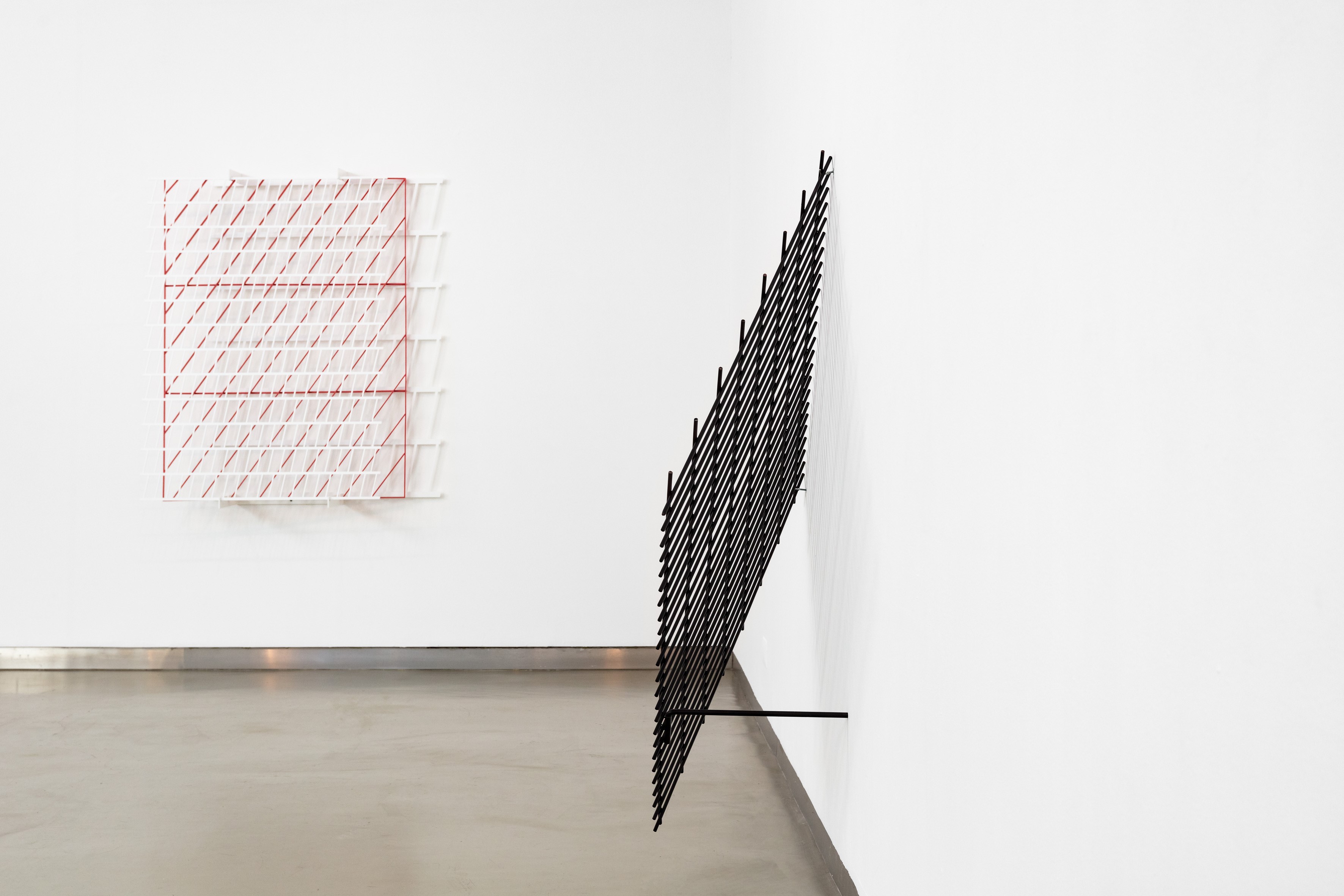Fernanda Fragateiro: A Monotonia é Fixe [Monotony is Nice]

The balance of tension
Fernanda Fragateiro's exhibition at Galeria Filomena Soares reveals a set of medium- and large-sized sculptures arranged in the venue's main room. Using as title the sentence "Monotony is Nice," stated by Charlotte Posenenske regarding the uniformity of a flat landscape, the exhibition relies upon the research Fragateiro has been developing on the work of several women artists and on how the latter have reacted against the art, political, and social system they have come from.
Fernanda Fragateiro crosses a set of references centred around Agnes Martin (paying particular attention to her 1960 drawing Aspiration), Charlotte Posenenske, and Cady Noland, operating on the notion of construction and repetition. The artist transforms the idea of norm and series, manipulating the arrangement of the works and the configuration of the gallery (covering one of the side entrances), and creates an intervention that intersects the scale of the object with the scale of architecture. Working on the reading and perception of space, but also on the questions inherent in the physical constitution of the works on display (problematised at the core of sculpture), Fragateiro produces a reflection on the idea of opposite; and opposing solidity and transparency, robustness and delicateness, she ponders on the boundary between the obvious and the subtle.
While Fragateiro finds in Agnes Martin a reference to the slope of the grid, distorting the predictability of its repetition, it is on Ponenenske that she bases the modulation of the structure that supports the former. Introducing new possibilities for it to multiply and adapt, regarded not only as a compositional matter but also as an action that stands in opposition to exclusivity, Fragateiro delineates a proposition of an aesthetic vein and a political gaze, all the more reinforced as it approaches Cady Noland and her power management devices. Therefore, in these works, a gaze is put forth that enquires into the format and marking of the border, or the act of delimiting, calling into question a system of fast consumption and wear that is countered by the proposition of an alternate slow, repeated (modular), adaptable time.
The sculptures on display are composed of long, flat, inter-articulated surfaces, working with the logic of what moves away and what is level. When the surfaces are undivided, they resemble walls that guide our trajectory and free our gaze. Here, the idea of barrier is shifted, and the works act as filters that enable us to see through to the other side. When the surfaces are comprised of different layers, in their form, size, and position, they act upon the interstice they engender and capture that void into the body of the work. Expressivity thrives on the superposition of planes, colours, and grids that are apprehended in space, but also on the inter-combining projected shadows on the white walls of the room. Furthermore, the position and cadence they take on induce a diagonal displacement and a continuous reading that cuts across the gallery in depth.
Composed of lacquered metal sheets and tubes that outline and construct several grids, the sculptures allude to an imaginary of grilles and fences that block access and limit construction. Works such as Barreira antimotim (2020), Janela (2020), and Escadas (2020) invoke diverse elements from the artist's studio fashioned after the same drawing and colour; while Structures of Thought 1 (2020), Structures of Thought 2 (2020), Untitled (2020), and Untitled (2019–2020) take on a higher degree of abstraction.
Indeed, the sculptures explore a repetition that expands both vertically and horizontally, rendering the experience of reading and the comprehension of its composition into three-dimensionality. With exceptional assertiveness, the organisation of the pieces denotes rigour and lightness, bearing a resemblance to the perception of an embodied drawing or to the manifestation of a spatialised thought. However, in Barreira antimotim (2020), or Negative Dialectics (2020), Fragateiro incorporates elements directly extracted from the universe of construction (a blacksmith's support and a tubular support system) that contradict the surrounding slenderness and drive abstraction back into the real.
In a deliberate manner, the artist looks into an apparent opposition and summons up Theodor Adorno's writings, integrating his book Negative Dialectics (1966) into a sculpture of the same title. In doing so, the dichotomy between what is a barrier and what is permeable, or the difference between the delicateness of abstraction and the rawness of reality, takes on a new sense. In fact, the works explore an idea of opposite by drawing on the stress and resistance limits of the material. Thus, a riot-control fence leaning against a robust industrial support is rendered frail and careful, and a small grid originally drawn on paper acquires the might of an iron structure shouldered against the wall.
From the extrapolation of an idea to the manipulation of both material and knowledge of construction, to an awareness of space, Fernanda Fragateiro's works establish a reflection on sculpture itself. A reflection that cuts across times, artists, scales, and disciplines to form a field with new boundaries. A subtle field that works within a balance of forms, ideas, movements, and gazes, where repetition sets out another landscape.
Sérgio Fazenda Rodrigues is an Architect and Master in Architecture (Construction), he was a PhD student in Fine Arts and a PhD student in Architecture, where he investigates the spatial relationships between Architecture and Museology. Curates architecture and visual arts and joined the direction of the Portuguese section A.I.C.A. He developed, with João Silvério and Nuno Sousa Vieira, the editorial project Palenque. He was cultural consultant for the Regional Government of the Azores, having in charge, during this period, the construction of the contemporary art collection of the Archipelago - C.A.C.
Translation PT-EN: Diogo Montenegro.
Fernanda Fragateiro: A Monotonia é Fixe [Monotony is Nice]. Exhibition views at Galeria Filomena Soares. Photos: António Jorge Silva. Courtesy of the artist and Galeria Filomena Soares.



